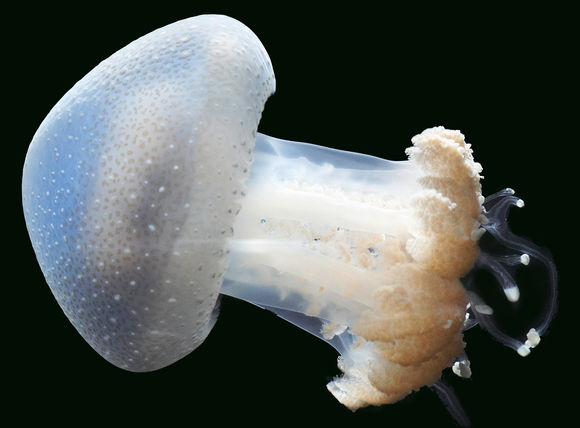
Dotted barrel jellyfish
Phyllorhiza punctata
One of our most beautiful jellyfish – the dotted barrel jellyfish – is one of nearly 80 species in the order of the barrel jellyfish. In comparison to the class of dangerous venomous box jellyfish, these fascinating specimens are harmless.
What you should know about jellyfish
Jellyfish are among the oldest species in the history of our planet and can still be found in all seas. The Cnidaria, seen floating across the water, are fascinating survivalists. After all, they have managed to survive 670 million years of evolution thanks to their adaptability.
Characteristics
- Origin
Pacific and Indian Ocean
- Habitat
Open ocean
- Diet
Plankton
- Status
is considered an invasive species
- Size
up to 35 cm
- Weight
above 1 kg
- Breeding period
Juvenile jellyfish to adult approx. 3 months
- Achievable age
depending on food supply up to one year
Threat Categories of IUCN


It also survives without a spine or brain
Jellyfishes' bodies consist of almost 99 per cent water and is an entity of inner and outer cell layers. An intermediate gelatinous mass supports and also serves as an oxygen depot. Jellyfish have a nervous system and sense organs, but no brain. Thanks to special sensory cells in their outer cell layer, they are able to, amongst other things, hunt prey, react to predators or identify sexual partners.
Watch out for the electric shock!
Jellyfish belong to the clan of cnidaria. Stinging cells can be found on their tentacles, which quickly release a poison on contact, which causes severe pain to a greater or lesser extent. The effect is known from stinging nettles. Depending on the species of jellyfish, the stinging venom has as a harmless stinging effect or at worse, can be lethal. Vinegar is able to relieve light burning – in all other cases you must go to the doctor immediately!
Jellyfish research behind the scenes of Aquarium Berlin
What our visitors don't see is that our keepers have been researching, breeding and experimenting behind the scenes for many years now, with patience and sure instinct. As the world's only inland aquarium that breeds so many different jellyfish species even in synthetic sea water, we are the first point of contact for European marine biologists as well as researchers from South Africa and Israel.
Is it true, that ...?
... some jellyfish change their sex? Yes, specifically as a hermaphrodite with everything that goes with it. Mostly they are male at the start of their lives, then simultaneously male and female, which enables them to fertilise themselves, and ultimately pure female.

